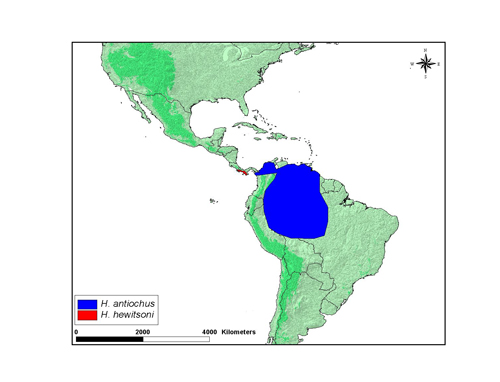Heliconius antiochus
Margarita Beltrán and Andrew V. Z. BrowerIntroduction
Heliconius antiochus is a member of the sara-sapho group, and a Müllerian mimic of Heliconius wallacei, H. sara and H. congener. The wings are blue-black, with two transverse white or yellow bands on the distal part of the forewings.Characteristics
H. antiochus adults may be distinguished from mimics by the pattern of red basal spots and streaks on the ventral surface of the hindwing.Early stages: Eggs are yellow and approximately 1.1 x 0.8 mm (h x w). Females usually place 5 to 40 eggs on growing shoots of the host plant. Mature larvae have a yellow body with black scoli and head; length is around 1.2 cm. Caterpillars are gregarious (Brown, 1981)
Geographical Distribution
Heliconius antiochus is disributed from Panama to the Amazon. The map below shows an approximate representation of the geographic distribution of this species. The original data used to draw these maps is derived from Brown (1979) which is available at Keith S. Brown Jr. (1979). Ecological Geography and Evolution in Neotropical Forests .
Habits
H. antiochus occurs from sea level to 1,000 m in riparian forest. Usually individuals fly slowly and in the canopy. The males sit on female pupae a day before emergence, and mating occurs the next morning, before the female has completely eclosed. Adults roost at night in large groups on twigs or tendrils over water (Brown, 1981).
Host plant: H. antiochus larvae feed primarily on plants from the genus Passiflora, subgenus Astrophea (Brown, 1981).
Geographical Races
H. antiochus has formed several geographical races, as follows:Heliconius antiochus antiochus (Linnaeus, 1767) widespread east of the Andes from Venezuela to Peru
Heliconius antiochus aranea (Fabricius, 1793) eastern side of the Cordillera de Mérida, Venezuela
Heliconius antiochus araneides Staudinger, 1897 Venezuela
Heliconius antiochus salvinii Dewitz, 1877 eastern Venezuela (an interesting form with a broad transverse yellow band on the hindwing, reminiscent of the pattern of the allopatric H. cydno weymeri).
Lamas (2004) lists a further undescribed subspecies from eastern Peru.
References
Brown K. S. 1981 The Biology of Heliconius and related genera. Annual Review of Entomology 26, 427-456.
Lamas, G. 2004. Atlas of Neotropical Lepidoptera. Checklist: Part 4A Hesperioidea - Papiionoidea in J. B. Heppner, ed. Scientific Publishers/Association of Tropical Lepidoptera, Gainesville.
Linnaeus C. 1767. Systema naturae. Editio duodecima reformata. Holmiae, Laurentius Salvius. 1(2): [ii] , 533-1328 , [36] pp.
Title Illustrations

| Scientific Name | Heliconius antiochus |
|---|---|
| Location | Rondonia, Brazil |
| Specimen Condition | Live Specimen |
| Source | Anitochus Longwing |
| Source Collection | Neotropical Butterflies |
| Copyright | © 2002 Will and Gill Carter |
About This Page

University of Cambridge, Cambridge, UK

Middle Tennessee State University, Murfreesboro, Tennessee, USA
Correspondence regarding this page should be directed to Margarita Beltrán at and Andrew V. Z. Brower at
Page copyright © 2010 and
 Page: Tree of Life
Heliconius antiochus .
Authored by
Margarita Beltrán and Andrew V. Z. Brower.
The TEXT of this page is licensed under the
Creative Commons Attribution-NonCommercial-ShareAlike License - Version 3.0. Note that images and other media
featured on this page are each governed by their own license, and they may or may not be available
for reuse. Click on an image or a media link to access the media data window, which provides the
relevant licensing information. For the general terms and conditions of ToL material reuse and
redistribution, please see the Tree of Life Copyright
Policies.
Page: Tree of Life
Heliconius antiochus .
Authored by
Margarita Beltrán and Andrew V. Z. Brower.
The TEXT of this page is licensed under the
Creative Commons Attribution-NonCommercial-ShareAlike License - Version 3.0. Note that images and other media
featured on this page are each governed by their own license, and they may or may not be available
for reuse. Click on an image or a media link to access the media data window, which provides the
relevant licensing information. For the general terms and conditions of ToL material reuse and
redistribution, please see the Tree of Life Copyright
Policies.
- First online 18 February 2007
- Content changed 21 July 2010
Citing this page:
Beltrán, Margarita and Andrew V. Z. Brower. 2010. Heliconius antiochus . Version 21 July 2010 (under construction). http://tolweb.org/Heliconius_antiochus/72945/2010.07.21 in The Tree of Life Web Project, http://tolweb.org/







 Go to quick links
Go to quick search
Go to navigation for this section of the ToL site
Go to detailed links for the ToL site
Go to quick links
Go to quick search
Go to navigation for this section of the ToL site
Go to detailed links for the ToL site